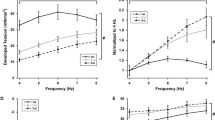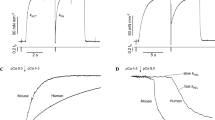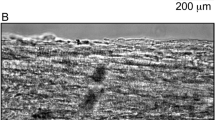Summary
Tension responses of rat ventricular trabeculae subjected to successive ‘treatment’ with EGTA and Triton X-100 are described in order to investigate the effects of chemical ‘skinning’ techniques. In some preparations the alkaloid saponin was also used before Triton. Ultrastructural evidence is cited that the ‘EGTA-treatment’ fails to render cells ‘hyperpermeable’, i.e. freely permeable to small ions, whereas both saponin and Triton do so. In this paper we show that contractile responses like those described previously for the ‘EGTA-treated’ tissue can be obtained. However, more detailed examination shows that such behaviour is quantitatively distinct from that of conventionally skinned fibres in a way that is incompatible with the notion of ‘hyperpermeability’. The Ca-sensitivity after treatment with either EGTA, saponin or Triton is identical in our hands. However, this is not explained by free access of Ca (and EGTA) to the intracellular space in the EGTA-treated preparation: contractures develop with very different time courses, being fastest after Triton and only marginally slower when first exposed to saponin but a factor of five times slower after ‘EGTA-treatment’ alone. This applies to contractures evoked direct from Ca2+ concentration ⋍ 10−9 m to the test Ca2+ concentration at constant total buffer concentration.
‘EGTA-treated’ fibres develop tension when ATP or creatine phosphate (CrP) are removed from the bath. However, responses to ADP and to CrP changes persist with millimolar levels of ATP present, quite unlike the Triton-skinned muscle. Exposure to each of a variety of solutions for 24h produce preparations showing similar behaviour: whatever the explanation for the EGTA-‘skinning’ phenomenon it is not dependent upon low bathing Ca2+ concentration. On the basis of the functional characteristics described here, and the structural results cited, we conclude that the cell membrane continues to function as a selective permeability barrier after ‘EGTA-treatment’: this treatment does not produce a model of a selectively ‘skinned’ cardiac cell.
Similar content being viewed by others
References
ABBOTT, R. H. & LEECH, A. R. (1973) Persistence of adenylate kinase and other enzymes in glycerol extracted muscle.Pflügers Arch. 344, 233–43.
ABOOD, L. G., KOKETSU, K. & MIYAMOTO, S. (1962) Outflux of various phosphates during membrane depolarisation of excitable tissues.Am. J. Physiol. 202, 469–74.
ALMERS, W., FINK, R. & PALADE, P. T. (1981) Calcium deprivation in frog muscle tubules: the decline of calcium current under maintained depolarization.J. Physiol. 312, 177–208.
ARMSTRONG, C. M., BEZANILLA, F. M. & HOROWICZ, P. (1972) Twitches in the presence of ethylene glycol bis (beta-amino-ethyl ether)-N,N′-tetraacetic acid.Biochim. biophys. Acta. 267, 605–8.
ASHLEY, C. C. & MOISESCU, D. G. (1977) Effect of changing the composition of the bathing solution upon the isometric tension-pCa relationship in bundles of crustacean myofibrils.J. Physiol. 207, 627–52.
BARRETT, J. N. & BARRETT, E. F. (1978) Excitation-contraction coupling in skeletal muscle: blockade by high extracellular concentrations of calcium buffers.Science 200, 1270–2.
BEELER, G. W. & REUTER, H. (1977) Reconstruction of the action potential of ventricular myocardial fibres.J. Physiol. 268, 177–210.
BENNETT, J. P., COCKCROFT, S. & GOMPERTS, B. D. (1982) Rat mast cells permeabilized with ATP secrete histamine in response to calcium ions buffered in the micromolar range.J. Physiol. 317, 335–46.
BERS, D. (1982) A simple method for the accurate determination of free Ca in Ca-EGTA solutions.Am. J. Physiol. 242, C404–8.
BLINKS, J. R., PRENDERGAST, F. G. & ALLEN, D. G. (1976) Photoproteins as biological indicators.Pharmac. Rev. 28, 1–93.
BLINKS, J. R., WIER, W. G., HESS, P. & PRENDERGAST, F. G. (1982) Measurement of Ca2+ concentration in living cells.Prog. Biophys. molec. Biol. 40, 1–114.
BOYD, I. A. & FORRESTER, T. (1968) The release of adenosine triphosphate from frog skeletal musclein vitro.J. Physiol. 199, 115–35.
BRADLEY, C., HENDERSON, W. B. & MILLER, D. J. (1980) Selectivity of Ca-Na antagonism in cardiac muscle.J. Physiol. 310, 78–9P.
CLEMENS, M. G. & FORRESTER, T. (1981) Exacerbation of the calcium paradox with exogenous ATP in isolated rat heart.J. Physiol., Lond. 320, 121P.
COCKCROFT, S. & GOMPERTS, B. D. (1979) Activation and inhibition of calcium-dependent histamine secretion by ATP ions applied to rat mast cells.J. Physiol. 296, 229–44.
CORNELIUS, F. (1980) The regulation of tension in a chemically skinned molluscan smooth muscle.J. gen. Physiol. 75, 709–25.
CRANK, J. (1967)The Mathematics of Diffusion, 1st edn. Oxford: Clarendon Press.
DEITMAR, J. W. & ELLIS, D. (1980) Interactions between the regulation of the intracellular pH and sodium activity of sheep cardiac Purkinje fibres.J. Physiol. 304, 417–88.
ELDER, H. Y., MILLER, D. J. & SMITH, G. L. (1981) Ultrastructural and contractile properties of Triton- and EGTA-treated rat heart.J. Physiol. 318, 33–4P.
ENDO, M. & HNO, M. (1980) Specific perforation of muscle cell membranes preserved SR functions by saponin treatment.J. Musc. Res. Cell Motility 1, 89–100.
FABIATO, A. & FABIATO, F. (1978) Effects of pH on the myofilaments and sarcoplasmic reticulum of skinned cells from cardiac and skeletal muscle.J. Physiol. 276, 233–55.
FRY, C. H. & MILLER, D. J. (1984) The contribution of mitochondria to calcium metabolism and tension generation in cardiac muscle. InControl and Manipulation of Calcium Movement (edited by PARRATT, J.) pp. 87–106. New York: Raven.
GETTES, L. S. & REUTER, H. (1974) Slow recovery from inactivation of inward currents in mammalian myocardial fibres.J. Physiol. 240, 703–24.
GRINWALD, P. M. & NAYLER, W. G. (1981) Calcium entry in the calcium paradox.J. mol. cell. Cardiol. 13, 867–80.
HARRISON, S. M. & MILLER, D. J. (1984) Mitochondrial contribution to relaxation demonstrated in skinned cardiac muscle.J. Physiol., Lond. (in press).
HEMPLING, H. G., STEWART, C. C. & GASIC, G. (1969) The effect of exogenous ATP on the electrolyte content of TA3 ascites tumor cells.J. Cell. Physiol. 73, 133–40.
HIBBERT, M. G. & JEWELL, B. R. (1979) length-dependence of the sensitivity of the contractile system to calcium in rat ventricular muscle.J. Physiol., Lond. 290, 30P.
HAAS, H. G., MEYER, R., EINWÄCHTER, H. M. & STOCKEM, W. (1983) Intercellular coupling in frog heart muscle. Electrophysiological and morphological aspects.Pflügers Arch. 399, 321–35.
ISENBERG, G. & KLOCKNER, U. (1982) Calcium tolerant ventricular myocytes prepared by preincubation in a KB-medium.Pflügers Arch. 395, 6–18.
JEWELL, B. R. & KENTISH, J. (1982) Can inotropic agents alter maximum force production of EGTA-treated trabeculae from rat ventricle?J. Physiol. 330, 81–2P.
JOHANSSON, L. (1975) Some aspects of the constant ionic medium principle. Studies on Iron III Fluoride & Tris (propylenediamine) Cobalt III Iodide systems.Acta chem. scand. A29, 365–73.
KENTISH, J. C. & JEWELL, B. R. (1984) Some characteristics of Ca2+-regulated force production in EGTA-treated muscles from rat heart.J. gen. Physiol. 84, 83–100.
KERRICK, W. G. L. & BEST, P. M. (1974) Calcium ion release in mechanically disrupted heart cells.Science N.Y. 183, 435–7.
KUSHMERICK, M. J. & PODOLSKY, R. J. (1969) Ionic mobility in muscle cells.Science N.Y. 166, 1297–8.
LÉOTY, C. (1974) Membrane currents and activation of contraction in rat ventricular fibres.J. Physiol. 239, 237–49.
LÜTTGAU, H. C. & SPIECKER, W. (1979) The effects of calcium deprivation upon mechanical and electrophysiological parameters in skeletal muscle fibres of the frog.J. Physiol. 296, 411–29.
MARTELL, A. E. & SMITH, R. M. (1974)Critical Stability Constants. Vol. 1,Amino Acids. New York, London: Plenum Press.
MCCLELLAN, G. B. & WINEGRAD, S. (1978) The regulation of the calcium sensitivity of the contractile system in mammalian cardiac muscle.J. gen. Physiol. 72, 737–64.
MCCLELLAN, G. B. & WINEGRAD, S. (1980) Cyclic nucleotide regulation of the contractile proteins in mammalian heart muscle.J. gen. Physiol. 75, 283–95.
McGUIGAN, J., CORAY, A., BOYETT, M., FRY, C., MILLER, D. J. & WEINGART, R. (1980) Na/Ca exchange in mammalian ventricular muscle. Prox. XXVIIIInt. Physiol. Sci. Congress (Budapest).
MILLER, D. J. (1975) Diffusion delays and the rate of contracture development in frog heart muscle.Pflügers Arch. 359, R23.
MILLER, D. J. (1979a) Are cardiac muscle cells ‘skinned’ by EGTA or EDTA?Nature,277, 142–3.
MILLER, D. J. (1979b) in ‘Matters arising’.Nature,280, 700–2.
MILLER, D. J., ELDER, H. Y. & SMITH, G. L. (1985) Ultrastructural and X-ray microanalytical studies of EGTA- and detergent-treated heart muscle.J. Musc. Res. Cell Motility 6, 525–40.
MILLER, D. J. & MOISESCU, D. G. (1976) The effects of very low external calcium and sodium concentrations on cardiac contractile strength and calcium-sodium antagonism.J. Physiol. 259, 283–308.
MILLER, D. J. & MÖRCHEN, A. (1978) On the effects of divalent cations and ethylene glycol-bis-(betaaminooethyl) N,N,N',N'-tetraacetate on action potential duration in frog heart.J. gen. Physiol. 71, 47–67.
MILLER, D. J., SINCLAIR, J., SMITH, A. D. & SMITH, G. L. (1982) Measurement of sarcomere length and automated exchange of bathing solutions applied to the study of intact and chemically ‘skinned’ cardiac muscle.J. Physiol., Lond. 320, 11P.
MILLER, D. J. & SMITH, G. L. (1984a) EGTA purity and the buffering of Ca ions in physiological solutions.Am. J. Physiol. 246, C160–6.
MILLER, D. J. & SMITH, G. L. (1984b) Diffusion equation modelling of the differences in the mechanical behaviour of EGTA- and Triton-treated rat heart.J. Physiol., Lond. 346, 74P.
MOPE, L. G., MCCLELLAN, G. B. & WINEGRAD, S. (1980) Calcium sensitivity of the contractile system and phosphorylation of troponin in hyperpermeable cardiac cells.J. gen. Physiol. 75, 271–82.
MORGAN, J. P., de FEO, T. T. & MORGAN, K. G. (1984) A chemical procedure for loading the calcium indicator aequorin into mammalian working myocardium.Pflügers Arch. 400, 338–40.
MORGAN, J. P. & MORGAN, K. G. (1982) Vascular smooth muscle: The first recorded Ca2+ transients.Pflügers Arch. 395, 75–7.
MORGAN, J. P. & MORGAN, K. G. (1984) Stimulus-specific patterns of intracellular calcium levels in smooth muscle of ferret portal vein.J. Physiol. 351, 155–68.
PARKER, J. C., CASTRANOVA, V. & GOLDFINGER, J. M. (1977) Dog red blood cells: Na and K diffusion potentials with extracellular ATP.J. gen. Physiol. 69, 417–30.
REQUENA, J., DIPOLO, R., BRINLEY, F. J. & MULLINGS, L. J. (1977) The control of ionized calcium in squid axons.J. gen. Physiol. 70, 329–53.
REUBEN, J. P. & WOOD, D. S. (1979) In ‘Matters arising’.Nature 280, 700.
ROUGIER, O., VASSORT, G., GARNIER, D., GARGOUIL, Y. M. & CORABOEUF, E. (1969) Existence and role of slow inward current during the frog atrial action potential.Pflügers Arch. 308, 91–110.
SEEMAN, P. (1967) Transient holes in erythrocyte membranes during hypotonic hemolysis and stable holes in the membrane after lysis by saponin and lysolecithin.J. Cell Biol. 32, 55–7.
SILINSKY, E. M. & HUBBARD, J. I. (1973) Release of ATP from rat motor nerve terminals.Nature 243, 404–5.
SMITH, G. L. (1983)A functional and structural study of cardiac muscle subjected to membrane disruption techniques. Ph.D. Thesis, Glasgow University.
STEWAT, C. C., GASIC, G. & HEMPLING, H. G. (1969) Effect of exogenous ATP on the volume of TA3 ascites tumor cells.J. cell. comp. Physiol. 73, 125–32.
SUTHERLAND, P. J., STEPHENSON, D. G. & WENDT, I. R. (1980) A novel method for introducing Ca2+-sensitive photoproteins into cardiac cells.Proc. Aust. physiol. pharmac. Soc. 11, 160P.
TODA, N. (1974) Automaticity induced by Ca2+ chelating agents in isolated rabbit left atria.Jpn. J. Pharmac. 24, 747–61.
TRAMS, E. G. (1974) Evidence for ATP action on the cell surface.Nature 252, 480–2.
VAUGHAN-JONES, R. D., EISNER, D. A. & LEDERER, W. J. (1983) Ca2+ ions can affect intracellular pH in mammalian cardiac muscle.Nature 301, 522–4.
WEISBURG, A., MCCLELLAN, G., TUCKER, M., LIN, L. & WINEGRAD, S. (1983) Regulation of calcium sensitivity in perforated mammalian cardiac cells.J. gen. Physiol. 81, 195–211.
WINEGRAD, S. (1971) Studies of cardiac muscle with a high permeability to calcium produced by treatment with ethylenediaminetetraacetic acid.J. gen. Physiol. 58, 71–93.
WINEGRAD, S. (1973) Intracellular calcium binding and release in frog heart.J. gen. Physiol. 62, 693–706.
WINEGRAD, S. (1979) In ‘Matters arising’.Nature 280, 700.
Author information
Authors and Affiliations
Rights and permissions
About this article
Cite this article
Miller, D.J., Smith, G.L. The contractile behaviour of EGTA- and detergent-treated heart muscle. J Muscle Res Cell Motil 6, 541–567 (1985). https://doi.org/10.1007/BF00711914
Received:
Revised:
Issue Date:
DOI: https://doi.org/10.1007/BF00711914




